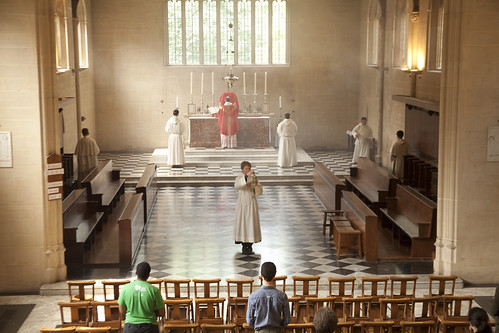 |
| The congregation is blessed with incense as the celebrant carries on the prayers and ceremonies at the Altar. Dominican Rite Mass in Oxford. |
The key point of the paper is that, while at least some 'special' lay roles in the liturgy are perfectly defensible - serving and singing being the obvious examples - even these don't exist for the sake of the liturgical participation of the people doing them. This is a crucial point. Without it the rest of the congregation may well feel excluded wrongly from graces available only to the parish elite.
The situation common in many parishes, of mass involvement of the laity in liturgical functions, can lead sometimes to an unedifying competition among lay people to be involved in this way. In other cases it can lead to a frantic attempt by the celebrant or some lay side-kick to conscript lay people for these roles in the minutes before Mass starts. It has become so embedded in the practice of the Novus Ordo that not long ago I noted on this blog that it hadn't apparantly occured to people that the celebrant could read the Epistle at Mass. If people aren't involved, the assumption is, if people are bustling about, then there is a problem. If this is so, there is a problem whenever there is more than a handful of people at a Mass, because the majority of them will not be 'involved' in this way. Pope St John Paul II was obliged to remind us that it is possible to participate by listening, and not only by speaking.
In the Position Paper the argument is made that this attitude towards liturgical involvement derives from clericalism: from the idea that only clerics count in the Church, and so lay people have to approximate to clerical status, or take over clerical roles, to join the party. Another aspect of the problem is that lay Catholics have forgotten what it is to participate in the liturgy in an interior and spiritual way. The experience of the Traditional Mass, with its silent canon encouraging a period of contemplative, and probably mostly wordless, prayer, is I know a challenge for some Catholics. Even those who come to love it can find it takes a bit of getting used to. It has something very important to teach the Church.
Here are some words from Pope Benedict on the silent canon.
Anyone who has experienced a church united in the silent praying of the Canon will know what a really filled silence is. It is at once a loud and penetrating cry to God and a Spirit-filled act of prayer. Here everyone does pray the Canon together, albeit in a bond with the special task of the priestly ministry. Here everyone is united, laid hold of by Christ, and led by the Holy Spirit into that common prayer to the Father which is the true sacrifice—the love that reconciles and unites God and the world.
They are quoted in the Position Paper on Silence available here.
Support the work of the LMS by becoming an 'Anniversary Supporter'.
A particular problem arises with children where the "all must have prizes" mentality prevails. We also see it where an NO Mass has an army of altar servers,most of whom have no function. It is indeed a problem with the NO that there is so little for servers to do.
ReplyDeleteWell said. Participation in the older rites is much fuller and more engaging than in the new.
ReplyDelete"cleansing the sacred vessels"
ReplyDeleteA minor point compared to the bigger issues, but there is an additional problem with the laity doing this.
Extraordinary Ministers are overwhelmingly female, priests are inevitably male. The uncomfortable image at the end of communion is of the man sitting down while the women do the washing up.
Ha ha, yes that's right.
DeleteIt is also forbidden by the Church's law.
And no priests from female altar servers, remember!
ReplyDelete